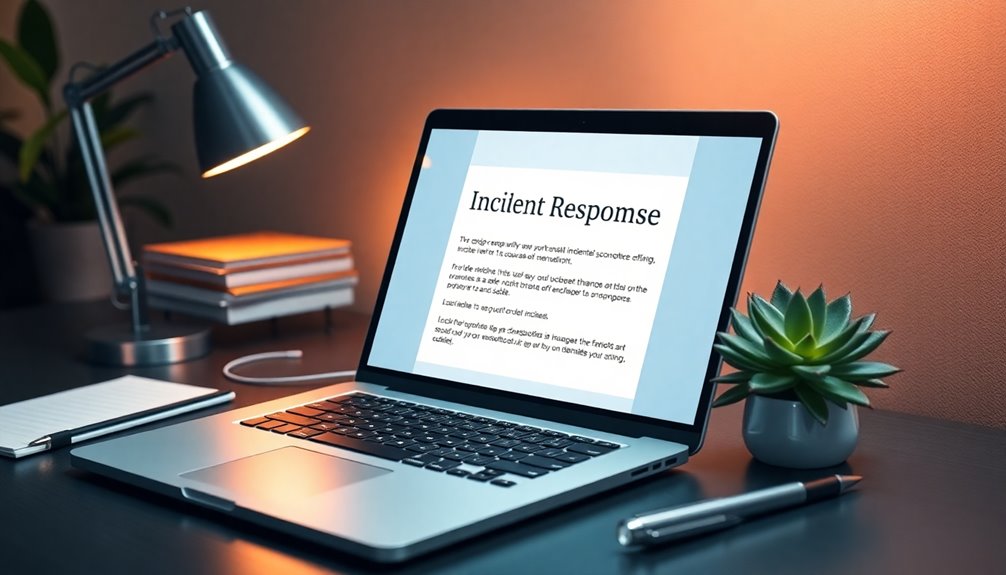An effective incident email template is your essential tool during emergencies. It ensures you communicate clearly and swiftly, covering all vital details. Start with a concise subject line to get attention. Clearly outline the incident's nature, immediate actions to take, and include contact information for support. This structure helps prevent panic and confusion, guiding everyone towards a calm response. Remember to customize your template for specific situations and avoid overwhelming information. If you're looking to enhance your team's crisis preparedness and want practical tips, there's much more you can explore to refine your communication strategy further.
Key Takeaways
- Use a structured format to clearly outline the incident's nature, immediate actions taken, and relevant contact information for quick reference.
- Customize templates for specific emergencies to ensure clarity and relevance, preventing confusion during critical situations.
- Keep language clear and concise, focusing on essential details to facilitate effective responses and minimize misunderstandings.
- Include actionable instructions with specified timelines to guide recipients on how to respond appropriately during the emergency.
- Regularly review and test templates to maintain effectiveness, ensuring employees are familiar with protocols and confident in their responses.
Introduction

In today's fast-paced world, being prepared for emergencies is crucial, and having an incident email template at your fingertips can make all the difference. These templates serve as essential tools for effective communication during critical situations, ensuring that everyone involved receives necessary information promptly.
When emergencies arise, time is of the essence; utilizing predefined incident email templates allows you to quickly convey critical information.
These templates typically include vital details like the nature of the incident, immediate actions required, and contact information for further assistance. By keeping your templates clear and concise, you help prevent confusion and panic, which can otherwise disrupt safety protocols. This promotes a calm and organized response among all stakeholders.
Moreover, incident email templates are easily customizable to fit various types of emergencies, enabling you to adapt your safety messages accordingly.
Regularly reviewing and updating these templates is essential, as it ensures they remain relevant and effective in addressing evolving emergency scenarios.
Enhances Employee Crisis Preparedness

Having a solid incident email template at your disposal significantly enhances employee crisis preparedness. During emergency situations, communication is crucial, and these templates streamline the flow of information, ensuring everyone receives critical updates quickly. By providing clear instructions on emergency procedures, you help employees respond effectively and confidently.
Utilizing customizable templates allows you to tailor messages to specific scenarios, making the communication even more relevant. This adaptability not only improves clarity but also aligns with your company policies, reinforcing the importance of safety. Regularly using incident email templates fosters a culture of preparedness, as employees stay informed about safety protocols and expectations.
Additionally, incorporating these templates into training sessions ensures that everyone understands how to use them when the time comes. Organizations with established incident communication protocols tend to experience faster recovery times and reduced panic among employees, demonstrating the value of being prepared.
Ultimately, when employees feel equipped to handle crises, they contribute to a safer work environment, enhancing overall employee preparedness. With a robust incident email template, you empower your team to act swiftly and decisively in emergencies.
Clear Subject Line

Effective communication during emergencies starts with a clear subject line that immediately conveys the message's urgency. When you send an email related to an incident, using a concise subject line is crucial. Incorporate keywords like "Emergency," "Alert," or "Notification" to enhance visibility and prompt immediate attention required from recipients.
For instance, a subject line like "Fire Alarm Activation: Immediate Attention Required" clearly indicates the type of incident and its urgency. Research shows that concise subject lines under 50 characters are more likely to be opened and read, particularly during urgent situations.
Consistency in your subject line format across the organization helps everyone recognize the email's importance and respond swiftly. This effective communication strategy supports incident reporting and ensures that emergency personnel are informed about workplace safety concerns promptly.
Incorporating these best practices not only aids in timely and accurate responses but also reinforces safety procedures during crises.
Crafting Clear Emergency Messages

Crafting clear emergency messages is essential for ensuring that everyone understands what to do during a crisis. Use clear and concise language to eliminate confusion, allowing recipients to quickly grasp the instructions.
Begin by outlining the nature of the emergency and include essential details that support an effective response. Specify the actions required from each individual and any relevant timelines to maintain order.
Tailor your message to address your audience's roles and responsibilities. This ensures that the information you provide is relevant and actionable, helping each person understand their specific actions required.
Don't forget to include contact information, so recipients can reach out for further inquiries or support if needed. This is crucial in emergencies when clarity is key.
Additionally, regularly update and test your emergency message templates. Keeping them effective and relevant is vital as procedures or organizational structures change.
Make sure your messages cover aspects like safety procedures and reporting potential hazards, as these are crucial for maintaining safety during a crisis.
Pro Tips for Maximizing Impact

To maximize the impact of your incident email template, focus on five key strategies that enhance clarity and responsiveness.
First, use clear and concise language to convey critical information effectively. Studies show that clarity can reduce confusion by up to 70%.
Next, include specific instructions that empower your audience to act decisively, minimizing panic during emergencies.
Third, craft a customizable subject line that reflects the nature of the emergency. This can improve open rates by 20%, ensuring timely awareness among stakeholders.
Fourth, always provide contact information for relevant support personnel or departments. This facilitates immediate assistance and fosters a sense of security among recipients.
Common Mistakes to Avoid

When you're drafting an incident email template, steer clear of common pitfalls that can undermine your message. One major mistake is failing to provide clear and concise instructions. In emergencies, effective communication is crucial; without it, recipients may panic or become confused about essential actions.
Another error is neglecting to customize the template for the specific incident type. This oversight can result in critical details being overlooked, hindering an appropriate response.
You also want to avoid overloading the email with unnecessary information. Too much content can dilute your key messages and make it harder for recipients to focus on what they need to do.
Timely communication is vital during emergencies. Ignoring this can exacerbate the situation, prolonging the impact of the crisis.
Moreover, always include contact information for further inquiries. Without it, recipients might feel unsupported and uncertain about next steps, reducing the effectiveness of your communication. Additionally, ensure that your email aligns with SMART criteria to enhance clarity and effectiveness in goal-oriented communication.
Emergency Notification Template Example

By prioritizing clarity in your language, you minimize confusion and promote a sense of urgency that's vital in emergencies.
Ultimately, maintaining a safe environment hinges on how effectively you convey critical alerts.
Your template can make a significant difference when every second counts.
Final Thoughts

Reflecting on the importance of effective incident email templates, it's clear that having a well-structured communication plan can be lifesaving during emergencies. When an incident occurs, swift response hinges on clear communication.
You need to ensure that your organization is prepared to act quickly, minimizing confusion and panic among employees. Customizable templates play a vital role, allowing you to tailor messages to specific situations, which enhances situational awareness and delivers relevant details and instructions. Additionally, having a clear understanding of advance directives can further guide decision-making during crises.
Regularly testing and updating your incident email templates is essential for familiarizing employees with emergency protocols. This practice cultivates a culture of preparedness that reinforces employee safety and well-being. Additionally, integrating effective frameworks like the Law of Attraction can help shift mindsets towards proactive problem-solving.
When you communicate using professional and clear language, it fosters trust and confidence among your team, showing your commitment to their protection.
Frequently Asked Questions
How to Write an Incident Report Email Sample?
To write an incident report email, start with a clear subject line. Briefly outline the incident details, describe what happened, and conclude with next steps. Keep it professional and ensure clarity for all recipients.
How to Write an Email for a Safety Issue?
When writing an email for a safety issue, clearly describe the hazard and its location. Use direct language, outline necessary actions, and provide contact details for further assistance to ensure everyone understands the urgency.
How Do You Send an Emergency Email?
To send an emergency email, identify the incident, gather details, and craft a clear subject line. Include concise instructions and relevant contacts, then send it promptly to all stakeholders for swift communication.
How Do You Write an Inclement Weather Email?
To write an inclement weather email, start with a clear subject line, detail the weather's impact, provide safety instructions, outline work schedule changes, and include contact info for supervisors to address concerns as needed.









